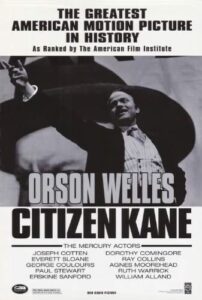“Citizen Kane” – a Landmark Work in The History of Cinema

Title: “Citizen Kane”
Release Date: 1941
Director: Orson Welles
Cast: Orson Welles, Joseph Cotten, Dorothy Comingore, Agnes Moorehead, Ruth Warrick, Ray Collins, Erskine Sanford, Everett Sloane
This film is among the top masterpieces of all time. This is due to both its formal mastery and its ambiguous and profound message. “Citizen Kane” is a story about the eternal struggle of man with the soulless world, in which money does not win.
Orson Welles made “Citizen Kane” in 1941. Already at the time of its release, the work was interpreted as a key film, as it was widely believed that the prototype of the title character was an American press magnate, William Randolph Hearst. The millionaire even tried to block the broadcast of Welles’ picture, but ultimately failed to win over the determined director. “Citizen Kane” is not a biographical film, however, and the title character has been portrayed so universally that he can be seen as any great businessman embodying the American myth of success. The role of Charles Foster Kane was played by Welles himself, while the author of the brilliant screenplay was Herman Mankiewicz.
“Citizen Kane” – structural innovation of Orson Welles’ film
“Citizen Kane” went down in the history of cinema as the first film in which the non-linear method of narration was masterfully used. The picture begins with the death of the main character, and we learn about his life in numerous flashbacks, which are the memories of friends and relatives of the millionaire. Kane, dying alone in his huge palace Xanadu in Florida, utters a mysterious word “rose”. It becomes the subject of investigation by a curious reporter who tries to explain the mystery of the great magnate through the prism of his last thought on his deathbed. In this way, a complex portrait of the protagonist emerges before the eyes of the viewer, who appears at one moment as an overbearing millionaire, at another as a born social activist, and at yet another as a troubled boy in search of love.

None of these faces of Kane is the real one, because there is still some missing element in the intricate puzzle, like in the puzzle toyed with by the magnate’s second wife, Mary (Agnes Moorehead). The puzzle motif is one of the numerous symbols of the film, signaling the unfathomable mystery. Orson Welles constantly emphasizes the frailty of human cognitive abilities, confuses clues and obliterates traces. The journalist’s investigation ultimately faces failure. It is impossible to guess what is really hidden in another person.
The structural innovation of “Citizen Kane” can be observed not only in the storyline, but also in the composition of the frame and individual scenes. One of the film’s most outstanding achievements is the simultaneous use of several planes, as in a shot from the protagonist’s childhood, when we simultaneously see his mother signing a bank contract at home, his anxious father in the background, while in the third (outside the window) little Charles carelessly sleds down the hill.
“Citizen Kane” – the failure of the American myth
“Citizen Kane” ironically deals with the American myth about the salutary influence of money on the lives of individuals and entire communities. Kane becomes a millionaire out of spite, as a result of his mother’s unexpectedly profitable transactions, and one gets the impression that his greatest desire is to rid himself of the burden of wealth. In one of the scenes, the character even says outright: “If I hadn’t been very rich, I might have been a really great man”. All the moves of the eccentric millionaire seem downright crazy, e.g. when he invests huge amounts of money in a failing newspaper, or resemble the play of a spoiled child when, for fun, he steals all the most prominent “aces of journalism” from the competition.

However, as if to spite himself, instead of leading himself to ruin, Kane gets even richer and builds a huge newspaper empire. Interestingly, by serving up news based on rumor and provocation, he comes across as the only voice of truth in America. Along the way, he repeatedly becomes intoxicated with his power and falls into a mania of grandeur. Of particular importance are the scenes of his political speeches, shot on a grand scale. The monumentalism of the shots and music make Kane look like the fascist dictators of the time (early 1940s). Nevertheless, since the protagonist cannot defeat the entire world, he builds his own private empire in which everything is arranged to his liking. This is best illustrated by the motif of building an opera house that Kane erects for his wife, a singer completely devoid of talent. With the press (public opinion) and the opera in his hands, the millionaire turns the inferior singer into a great diva. Incidentally, the audience of the time saw a clear allusion to Hearst’s relationship with the popular actress Marion Davies.
“Citizen Kane” – money versus love
Kane tries to make sense of his existence through, among other things, social action on behalf of the working poor. He also believes in the saving power of love. However, both his first (Dorothy Comingore) and second wife leave him, unable to stand her husband’s overbearing character. The progressive isolation of the protagonist and his wife Susan is shown in an excellent sequence of scenes over breakfast, in which passionate confessions are gradually replaced by perfunctory comments, and finally total indifference.
The breakdown of the relationship with his second wife, in turn, brilliantly illustrates the growing spatial distance between the characters. As the magnificent palace grows larger, the spouses are forced to shout to each other from two opposite corners of the chamber, accompanied by a characteristic reverberation. The eloquence of these scenes is reinforced by the purchase of more antiques and ancient sculptures, turning the place intended for living into a cold museum.

“Citizen Kane” – a Dickensian tale of “Great Expectations”
It is hard to resist the impression that “Citizen Kane” draws on the Dickensian motif of a poor boy who, by an extraordinary coincidence, manages to inherit a fortune and enter the elite world. At the same time Orson Welles clearly reevaluates this myth of liberation through money. For it is wealth that isolates Kane from the world and takes away from him what he loves most. The last scene of the film allows us to guess that the “rose” the protagonist had in mind is a drawing on his favorite childhood sled. Nevertheless, the whole truth will remain inaccessible, as the inscription on the gate of Kane’s kingdom appearing in the last frame proclaims: “No tresspassing”.
A.Grabicz, Kino, wehikuł magiczny. Przewodnik osiągnięć filmu fabularnego. Podróż pierwsza 1913 – 1949, Kraków 2007.
